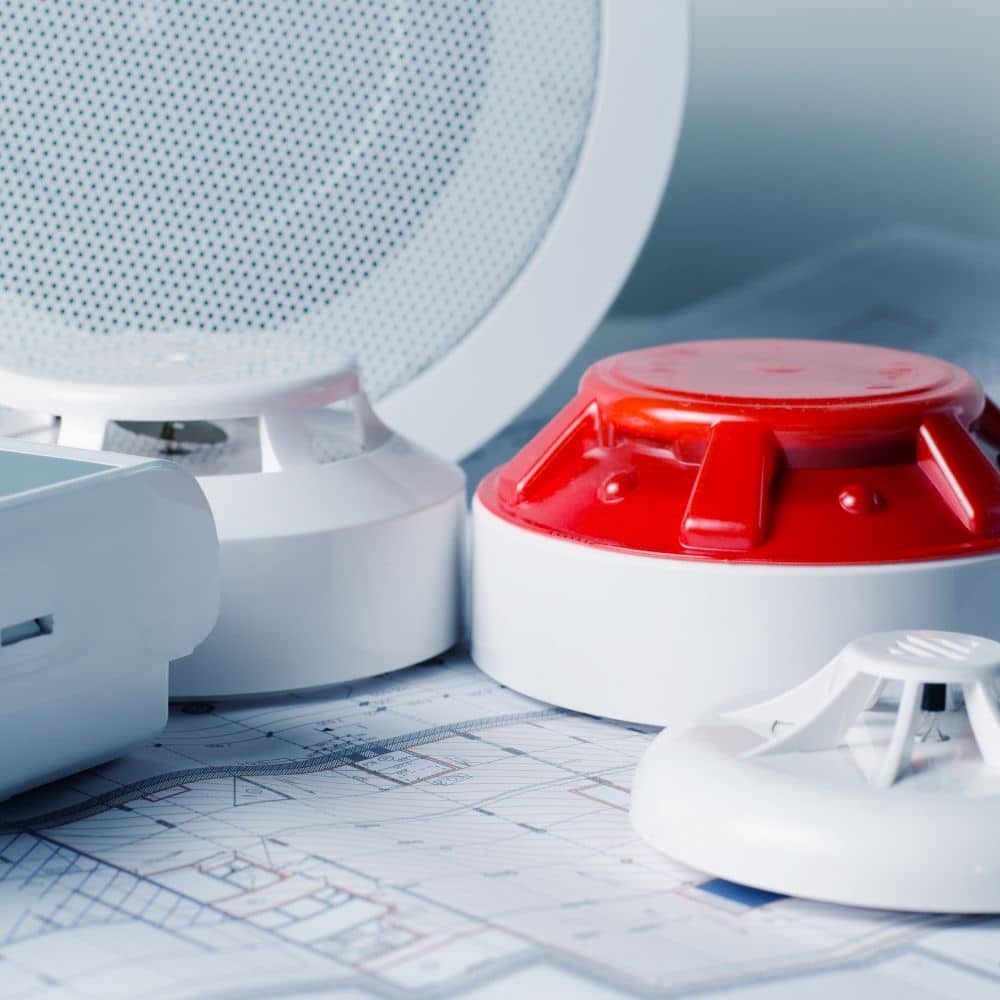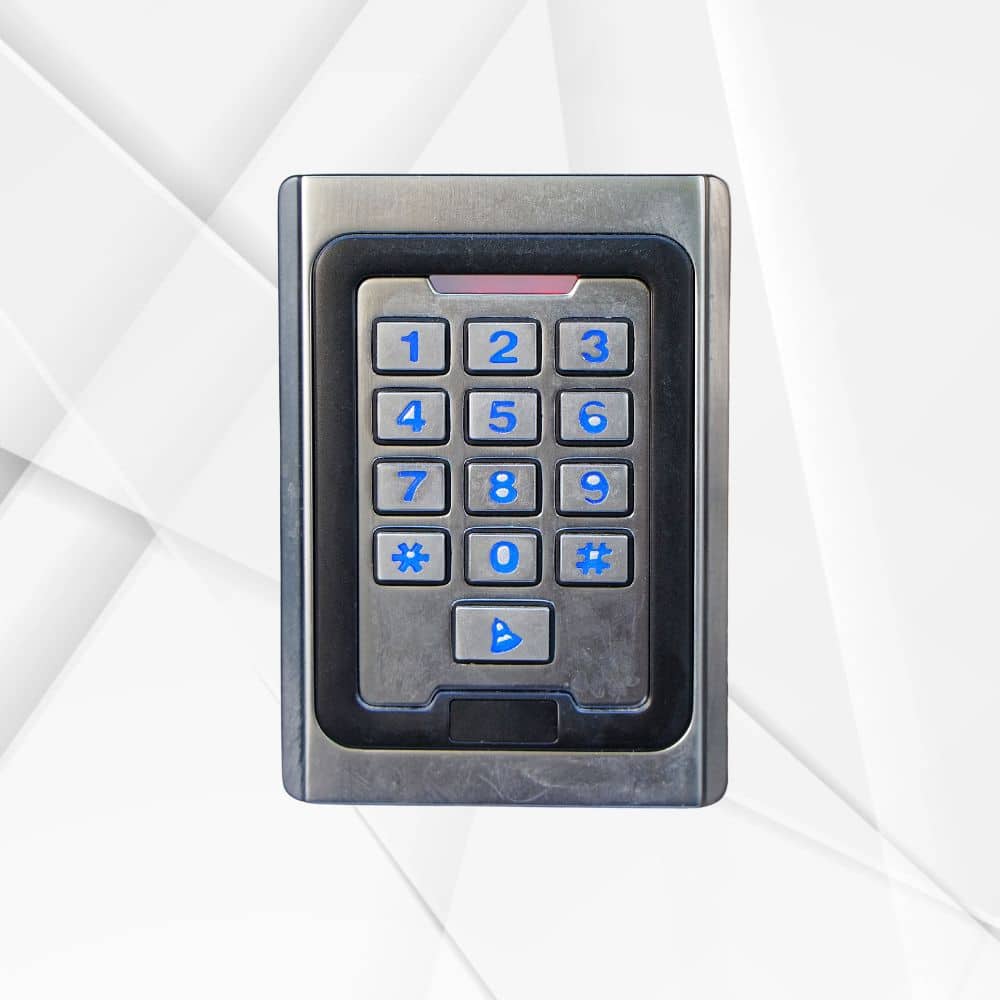- Motion Sensors
- Vibration Sensors
- Tilt Sensors
- Light Sensors
- Wired & Wireless Door Sensors
- Trip Wires
- Water & Moisture Sensors
- Temperature Sensors
- Smoke Sensors
- Panic Buttons (Internal & Remote)
- Alarms Triggered by Keypad Combos
- AI & Biometrics
- Power Failures
- Cameras
- Location-based Geofence
ATMs are a common target for theft and tampering, but advanced alarm systems help protect them from a variety of threats. Understanding what triggers an ATM alarm can help businesses, technicians, and ATM owners ensure that their machines are properly secured. Below, we’ll explore the most common sensors and mechanisms that set off ATM alarms and how they protect against tampering and theft.
1. Motion Sensors
Motion sensors are a standard feature in modern ATMs. These sensors detect any unauthorized movement around the machine. When someone attempts to physically tamper with or break into the ATM, the sensor registers the unusual motion and triggers the alarm. This system helps prevent common break-in methods like crowbar attacks, drilling, or forced entry.
What can cause the motion sensor to trip?
- Pushing or rocking the ATM
- Attempting to pry open components like cash trays or panels
- Hammering or physically striking the ATM
- Moving large objects or tools near the ATM
- Attempting to relocate the ATM using mechanical equipment
2. Vibration Sensors
Vibration sensors are designed to detect any sudden, forceful impact on the ATM. These sensors are sensitive to physical attacks like hammering, drilling, or even trying to forcibly remove cash trays. When an unusual vibration is detected, the alarm is triggered to notify authorities and prevent further tampering.
What can cause the vibration sensor to trip?
- Using drills, hammers, or crowbars to access the ATM
- Dropping heavy objects on the ATM or hitting it with force
- Attempting to dislodge the ATM from its fixed position
- Tools causing heavy vibrations inside the ATM
3. Tilt Sensors
Tilt sensors are another essential feature for ATMs. These sensors detect any attempt to move or tilt the ATM. Criminals often try to lift or relocate ATMs to a different location to access them more easily. Tilt sensors ensure that if the machine is tilted or lifted, the alarm is immediately triggered to prevent relocation theft.
What can cause the tilt sensor to trip?
- Lifting the ATM off its base
- Tipping or rocking the ATM with a dolly or other equipment
- Attempting to load the ATM into a vehicle
- Unauthorized repositioning, even if slightly tilted
4. Light Sensors
Light sensors play a key role in ATM security, particularly when detecting tampering inside the vault. If someone tries to open the ATM, the light sensor detects any sudden exposure to light inside the vault, which should normally remain dark. The alarm is then triggered, signaling unauthorized access. Similarly, changes in surrounding light levels (like switching off external lighting) can also activate the alarm, making it a versatile security measure.
What can cause the light sensor to trip?
- Opening the ATM vault or service panel
- Cutting power to ATM lights, triggering light level changes
- External light directed into the machine’s inner vault
- Sudden exposure to daylight in previously dark areas
5. Wired and Wireless Door Sensors
Wired and wireless door sensors monitor the opening and closing of access points to the ATM. These sensors are installed on the ATM’s vault door or service doors. If these doors are opened without authorization, the sensor triggers the alarm. Wireless door sensors offer flexibility and can be installed in more areas, while wired sensors are traditionally placed at key entry points, like cash vaults and maintenance panels.
What can cause the door sensor to trip?
- Opening the ATM’s vault or service doors without permission
- Tampering with door seals or hinges
- Breaking or cutting wires connected to the door sensors
- Unauthorized attempts to bypass entry points
6. Trip Wires
Trip wires are often used around ATMs placed in high-risk or isolated locations. These wires are set up as invisible perimeters around the ATM. If anyone crosses these boundaries or attempts to enter restricted areas around the machine, the alarm is triggered. Trip wires are especially useful in detecting proximity breaches, adding another layer of defense.
What can trigger a trip wire?
- Crossing into a restricted area near the ATM
- Tripping over or cutting the trip wire
- Crawling under or climbing over the ATM’s physical barriers
- Unauthorized approach within a predefined perimeter
7. Water & Moisture Sensors
Water sensors detect the presence of liquid inside the ATM, which may result from accidental flooding, leaks, or deliberate sabotage. If water is detected, the machine shuts down to prevent damage, and the alarm system is activated to alert security teams. Water sensors are vital in flood-prone or high-moisture environments.
What can cause the water sensor to trip?
- Water entering the machine due to flooding or leaks.
- Sabotage attempts using liquids like water or chemicals.
- Rainwater or condensation penetrating the ATM structure.
- Attempts to damage electronic components with liquid.
8. Temperature Sensors
Temperature sensors monitor the heat levels inside the ATM. If there’s a rapid increase in temperature, it could indicate a fire or an attempt to breach the machine using tools like blowtorches. The temperature sensor activates the alarm when extreme heat is detected, allowing for immediate response. This type of sensor ensures protection against fire hazards and physical attacks.
What can cause the temperature sensor to trip?
- Rapid temperature increases caused by fire or overheating
- Attempts to breach the ATM using blowtorches or cutting tools
- External weather conditions causing abnormal heat inside the machine
- Sudden heating due to equipment malfunction or sabotage

9. Smoke Sensors
Similar to temperature sensors, smoke sensors detect the presence of smoke in or around the ATM. These sensors act as early warning systems for fire and potential arson attempts. If smoke is detected, the alarm is triggered, allowing for rapid action before the ATM sustains severe damage.
What can cause the smoke sensor to trip?
- Fire or arson attempts causing smoke around or inside the ATM.
- Electrical short circuits producing smoke.
- Heat-generating tools creating smoke within the ATM’s electronics.
- Unauthorized fire-starting devices near the ATM.
10. Panic Buttons
ATMs often feature multiple types of panic buttons, allowing for quick and easy alarm activation in emergencies:
- Internal Panic Button: Hidden inside the ATM, this button is usually pressed by ATM technicians or service personnel in the event of a robbery or other emergency.
- Remote Panic Button: Carried by ATM owners or operators, this portable button allows them to trigger the alarm from a safe distance if they notice suspicious activity near the ATM.
- App-Activated Panic Button: Some modern ATMs allow remote alarm activation via a mobile app, providing additional convenience for authorized personnel.
These buttons provide rapid alarm activation, ensuring that security is alerted immediately during high-risk situations.
When would a panic button be used?
- A technician or ATM user pressing the internal panic button during a threat
- Store owners or cash handlers activating remote panic buttons
- Using an app-based panic button to signal a nearby emergency
- Triggering the alarm after noticing suspicious activity

11. Alarms Triggered by Keypad Combos
Some ATMs include a hidden feature where specific distress codes can be entered into the keypad during a transaction. If a user is under duress and forced to withdraw money, they can input a secret code that will still dispense the cash but simultaneously trigger a silent alarm, notifying authorities. This system offers additional security for customers in potentially dangerous situations.
When would the keypad trigger be used?
- Entering a predefined distress code (e.g., reversing the PIN) under duress
- Completing a transaction while silently alerting authorities
- Forced withdrawals where a distress code is used to prevent harm
- Using the keypad combo to discreetly trigger a silent alarm
12. Future Technology: AI and Biometric Sensors
As ATM technology continues to evolve, we may see more ATMs equipped with biometric sensors and AI-driven alarm systems. Biometric sensors could use facial recognition or fingerprint analysis to detect unauthorized access attempts, while AI systems can analyze behavior patterns around the ATM to predict and prevent attacks before they happen. These innovations will enhance existing alarm systems to provide even more robust protection.
What could trigger AI & Biometric ATM Sensors?
- Unauthorized access attempts using incorrect biometric data (e.g., mismatched fingerprints or facial recognition)
- Suspicious behavior patterns detected by AI, such as loitering or erratic movements around the ATM
- Attempts to spoof biometric systems, like using a photo or dummy fingerprint
- Covering or tampering with the biometric scanner, such as the fingerprint reader or facial recognition camera
- Frequent failed authentication attempts, suggesting possible unauthorized access
13. Power Failure Detection on Critical ATM Equipment
Modern ATMs are equipped with sensors that monitor the functionality of critical systems, including power supplies and essential hardware. If power fails on any key component, such as the cash dispenser, communication modules, or vault systems, the alarm is triggered. This ensures the ATM remains secure and that any tampering or malfunction is detected quickly.
What can cause the power sensor to trip?
- Power failure or disruption in the ATM’s main systems, such as the vault or cash dispenser
- Tampering with power cables or cutting off the ATM’s electricity supply
- Malfunction or sabotage of the backup battery or power systems
- Unauthorized attempts to disable ATM equipment via electrical manipulation
14. Camera-Based Sensors
Camera-based sensors integrated with AI systems can detect suspicious activity around the ATM and trigger an alarm. These cameras are used for real-time monitoring and analysis of potential threats. They may also detect when a camera is obscured, disabled, or tampered with, immediately triggering a security response.
What can cause the camera sensor to trip?
- Obscuring the camera’s view with an object, tape, or spray paint
- Suspicious movements or loitering around the ATM, detected by AI algorithms
- Cutting power or disconnecting the camera system
- Physical tampering with or attempting to disable the camera
15. Location-Based Geofence GPS Sensors
Location-based geofence triggers create a virtual perimeter around the ATM’s designated area. If the ATM is moved outside of this predefined boundary, the geofence triggers an alarm, providing real-time alerts for unauthorized relocations. This technology is particularly useful for preventing thefts where ATMs are physically relocated.
What can trip the geofence sensor?
- The ATM is moved beyond its designated geofence boundary
- Unauthorized transportation or relocation of the ATM
- Attempts to bypass GPS tracking by moving the ATM to an unauthorized location
- Crossing the geofence perimeter with the ATM during maintenance or service without proper authorization
Conclusion on ATM Alarm Triggers
From motion and vibration sensors to panic buttons and tilt detectors, ATM alarm systems are designed to detect a wide range of security threats. Wired and wireless door sensors, trip wires, and even smoke and water sensors add additional layers of protection. With the ongoing evolution of security technology, including biometric sensors and AI surveillance, ATMs are becoming safer and more secure than ever before.
If you’re responsible for managing or maintaining ATMs, understanding what triggers an ATM alarm is crucial for ensuring the protection of your assets and the safety of your customers. By integrating these advanced systems, businesses can mitigate the risks associated with ATM tampering and theft.

